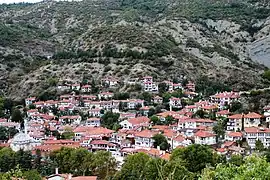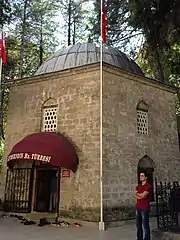Göynük | |
|---|---|
 | |
 Göynük Location in Turkey | |
| Coordinates: 40°23′59″N 30°47′07″E / 40.39972°N 30.78528°E | |
| Country | Turkey |
| Province | Bolu |
| District | Göynük |
| Government | |
| • Mayor | Ahmet Çankaya (MHP) |
| Population (2021)[1] | 4,376 |
| Time zone | TRT (UTC+3) |
| Website | www |
Göynük is a town in Bolu Province in the Black Sea region of Turkey. It is the seat of Göynük District.[2] Its population is 4,376 (2021).[1] The mayor is Ahmet Çankaya (MHP), elected in 2019.[3] Its neighbours are Mudurnu from north-east, Nallıhan from south-east, Sarıcakaya from south, Yenipazar from south-west, Taraklı from west and Akyazı from north-west.
History
The area has a long history of occupation going back to the Phrygians, Lydians, Persians and Ancient Romans. It was known as Koinon Gallicanon in antiquity. The Çatak Hamamı bathhouse dates back to the Roman times. Göynük was absorbed into the Ottoman Empire in the early 14th century. In the late 19th and early 20th century, Göynük was part of the Kastamonu Vilayet of the Ottoman Empire.
Sights

Göynük has over 100 early 20th century Ottoman Empire period houses, these plus the even older mosques, tombs, fountains, and Turkish baths makes it a town of great historical interest, and an attractive location of narrow streets, with a pretty stream running through the centre. The victory tower on the hill at the top of the town and the old Ottoman mansion called "Müderrisoğlu Konağı" at the centre are important landmarks of Göynük.
The most significant entombed saint of Göynük is Akshamsaddin (Turkish: Ak Şemsettin) (1389-1459), an influential Ottoman religious scholar, poet, mystic saint, and guide of Mehmed the Conqueror.[4][5]
Trivia
Göynük was used as a location of films including Akrebin Yolculuğu by Ömer Kavur, El Yazısı and a number of Turkish TV series e.g. Aynalar and Rüzgarlı Bahçe.
Notable natives
- Göynüklü Ahmed Efendi, 18th-century Ottoman bureaucrat, diarist and historian.
- Bıçakçı Ömer Dede, original name Omar Sikkin, an edge tool maker and student of Haji Bayram Wali.[6][7]
- Debbağ Dede, a tanner known for his miracle during the Hajj pilgrimage.[8][9]
- Aksungur Dede, one of the first ghazis to cross from Anatolia to Rumelia, 14th-15th century.[10]
References
- 1 2 "Address-based population registration system (ADNKS) results dated 31 December 2021" (XLS) (in Turkish). TÜİK. Retrieved 30 January 2023.
- ↑ İlçe Belediyesi, Turkey Civil Administration Departments Inventory. Retrieved 30 January 2023.
- ↑ Biography of Ahmet Çankaya, Göynük Municipality. Retrieved 13 February 2023.
- ↑ "A Part of the Eyoub (i.e., Uyüp) Cemetery, I, Constantinople, Turkey". 1 January 1890. Retrieved 11 March 2017.
- ↑ "Sûfîlere Yöneltilen Tenkitlere Bir Cevap: Akşemseddin ve Def'U Metâini's-Sûfiyye İsimli Eseri". Archived from the original on 2017-09-11. Retrieved 2016-11-16.
- ↑ "Türbeler - Göynük – BOLU". Archived from the original on 29 September 2010. Retrieved 11 March 2017.
- ↑ Bıçakcı Ömer Dede (k.s.)
- ↑ "Türbeler - Göynük – BOLU". Archived from the original on 29 September 2010. Retrieved 11 March 2017.
- ↑ "Göynük Evliyaları". Retrieved 11 March 2017.
- ↑ "Göynük Evliyaları". Retrieved 11 March 2017.